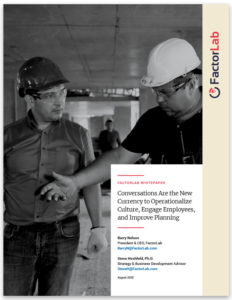Conversations Are the New Currency to Operationalize Culture, Engage Employees, and Improve Planning
We know that organizations with effective daily planning conversations get more done and do it more safely than those who don’t.
And yet, while there is extensive research supporting this assertion, little has been done to effectively aggregate and analyze the impact of daily planning conversations on worker productivity and jobsite culture. That is, until now.
For the first time, C-suite leaders are able to assess whether their aspirational culture and employee engagement levels are being fully realized in the field as demonstrated by what takes place during the informal, unfiltered conversations that frontline leaders and work teams have every day. Together with AI and machine learning, recent advances in video and mobile technology have created breakthroughs in our ability to capture and process these conversations to understand how work is being done and how serious injuries and catastrophic events and fatalities (SIFs) can be avoided.
These advancements have never been more vital than during the current COVID-19 pandemic. Leaders need to convey caring to motivate employees to collaborate and engage safely with others. Access to daily conversations allows them to identify and prioritize needed investments in training, leadership development, and rewards and recognition.
This paper lays out a vision and an actionable road map for executive leaders to capitalize on the opportunities emerging technologies provide. We examine and synthesize the work of 27 academic researchers and leading management consultants. Each reinforces the importance of daily planning conversations as opportunities for long-term competitive advantage, high-performance organizational health, and worker safety.
This whitepaper is a valuable resource for the CEO and COO, safety and risk leadership, heads of HR, operations executives, and technologists whose role is to bring advances into the company. Most importantly, it is for the safety management and frontline supervisors who are the ones on point to seize on theory to save lives.







